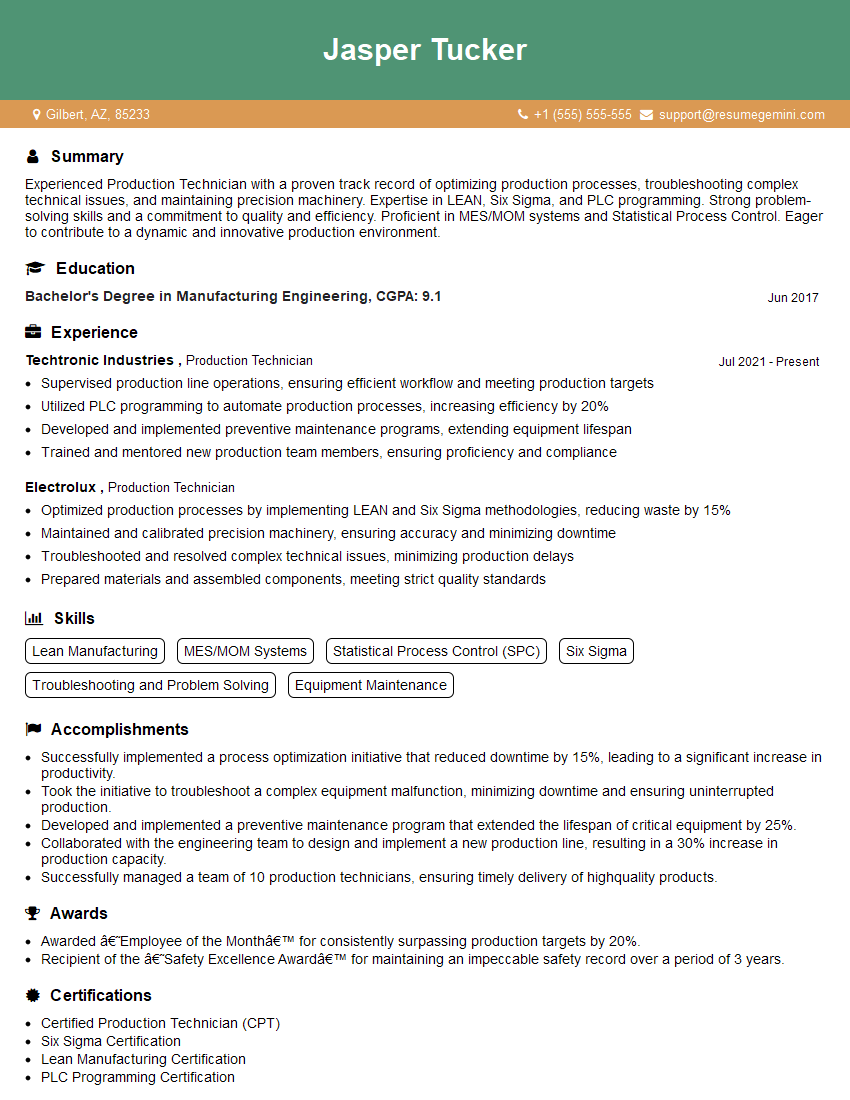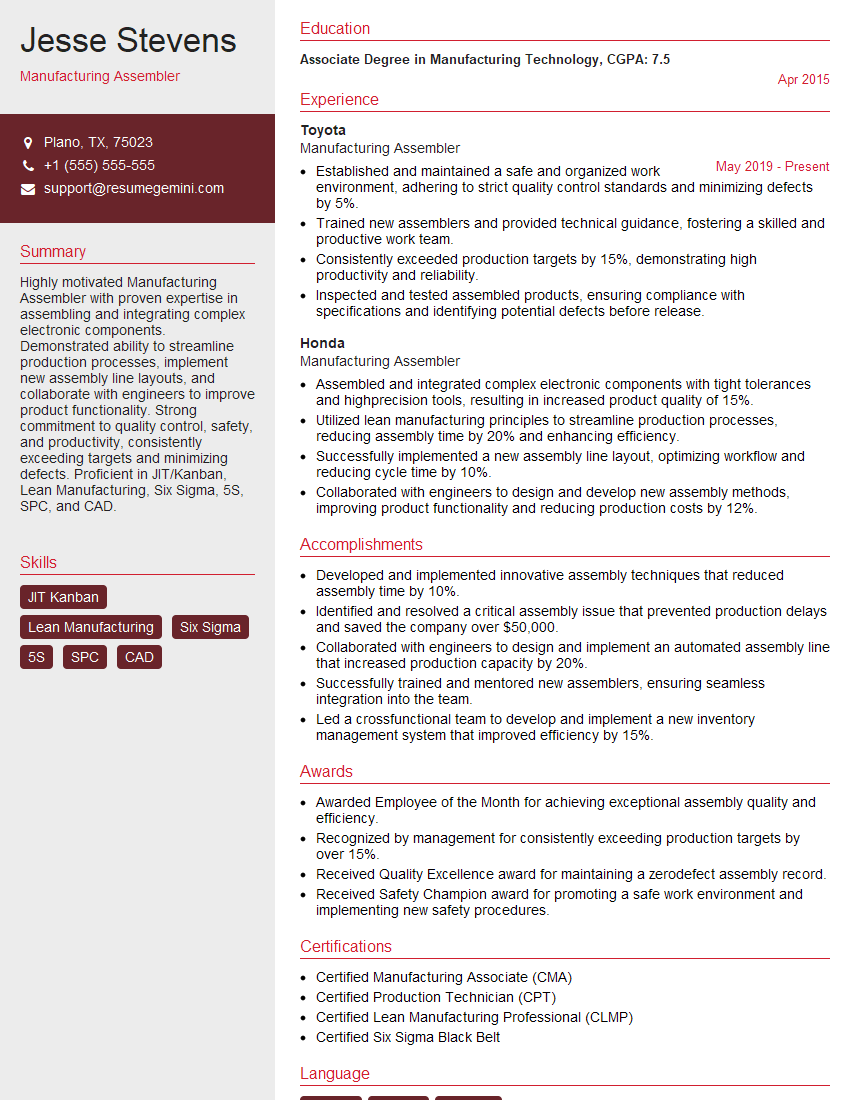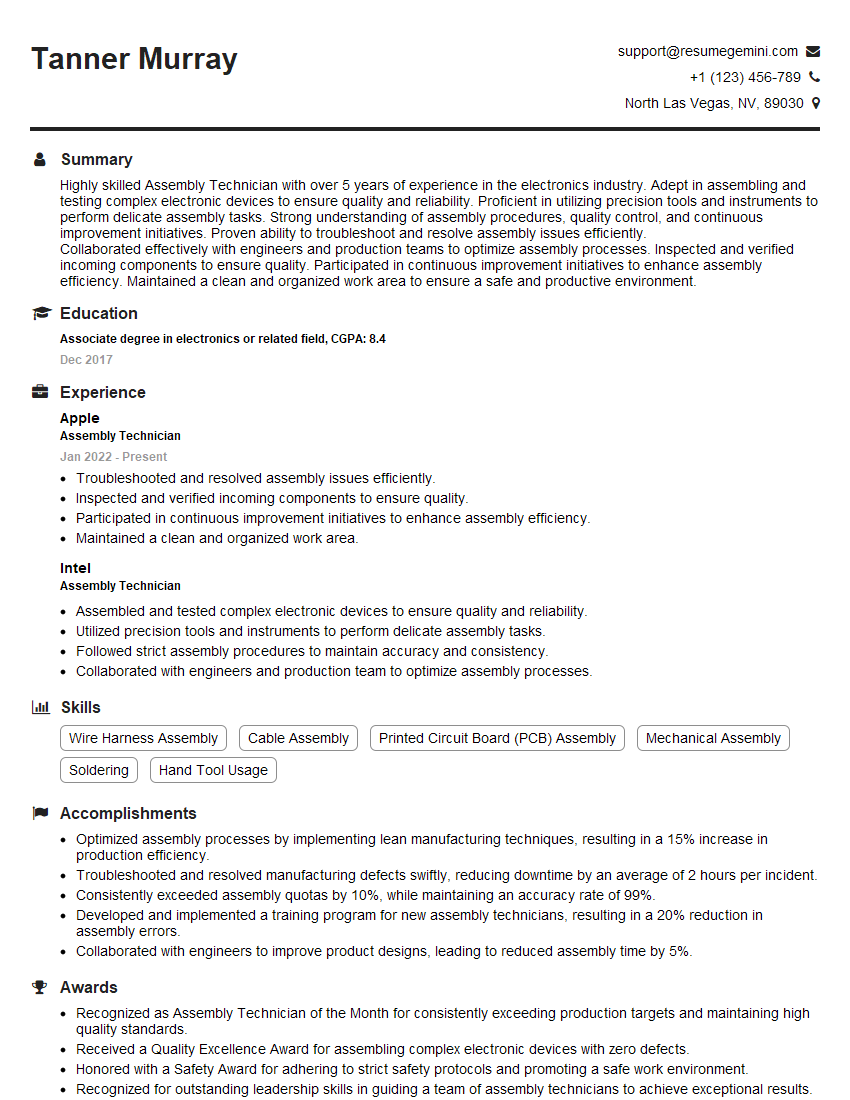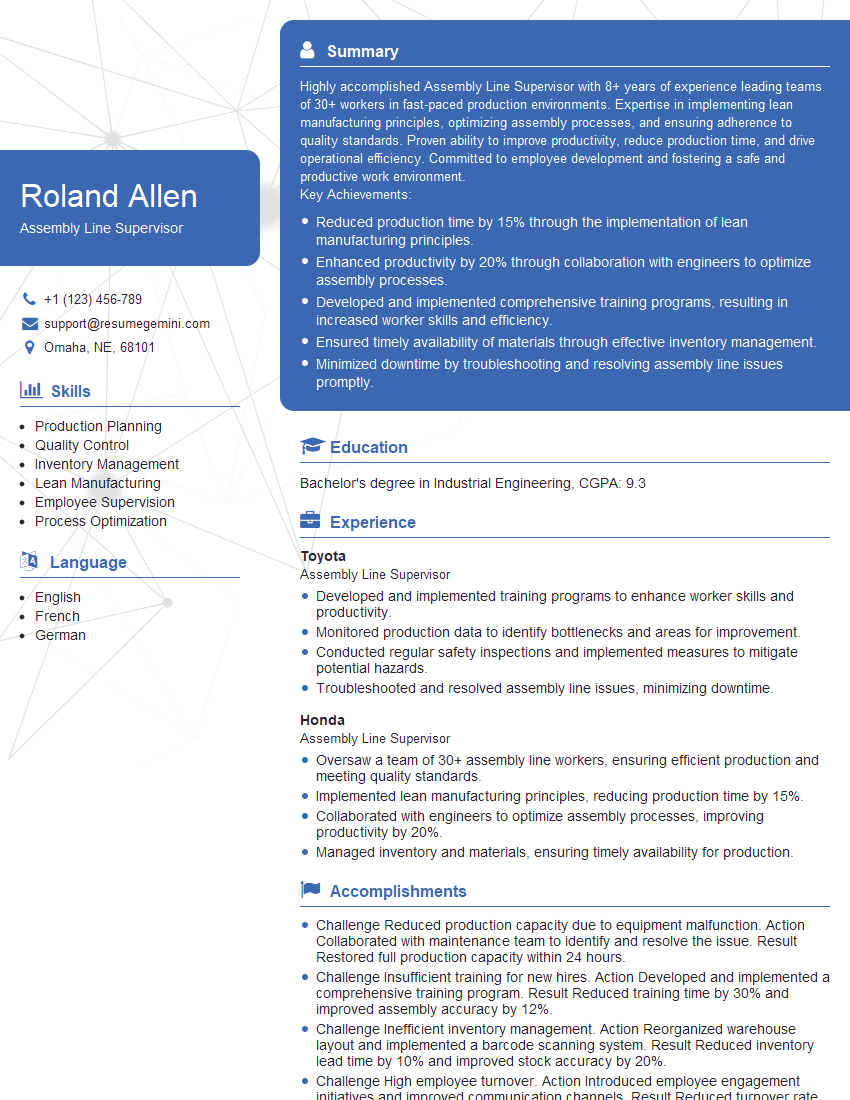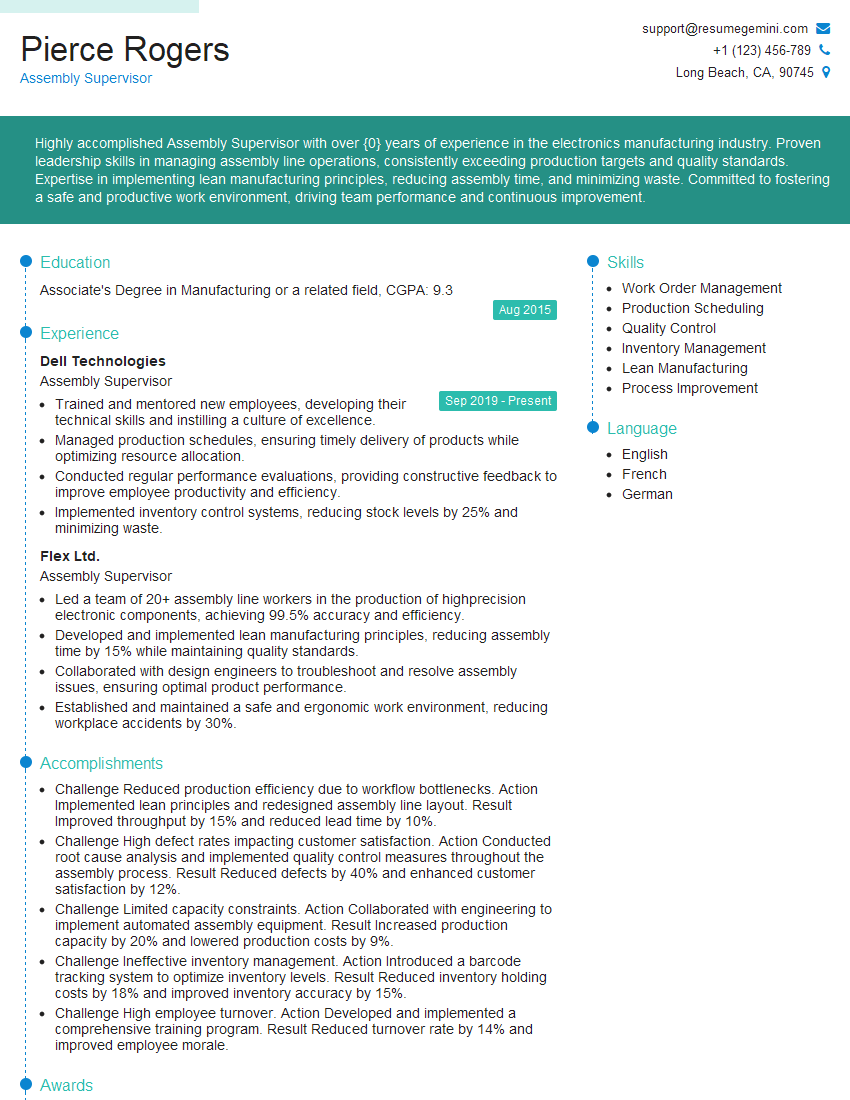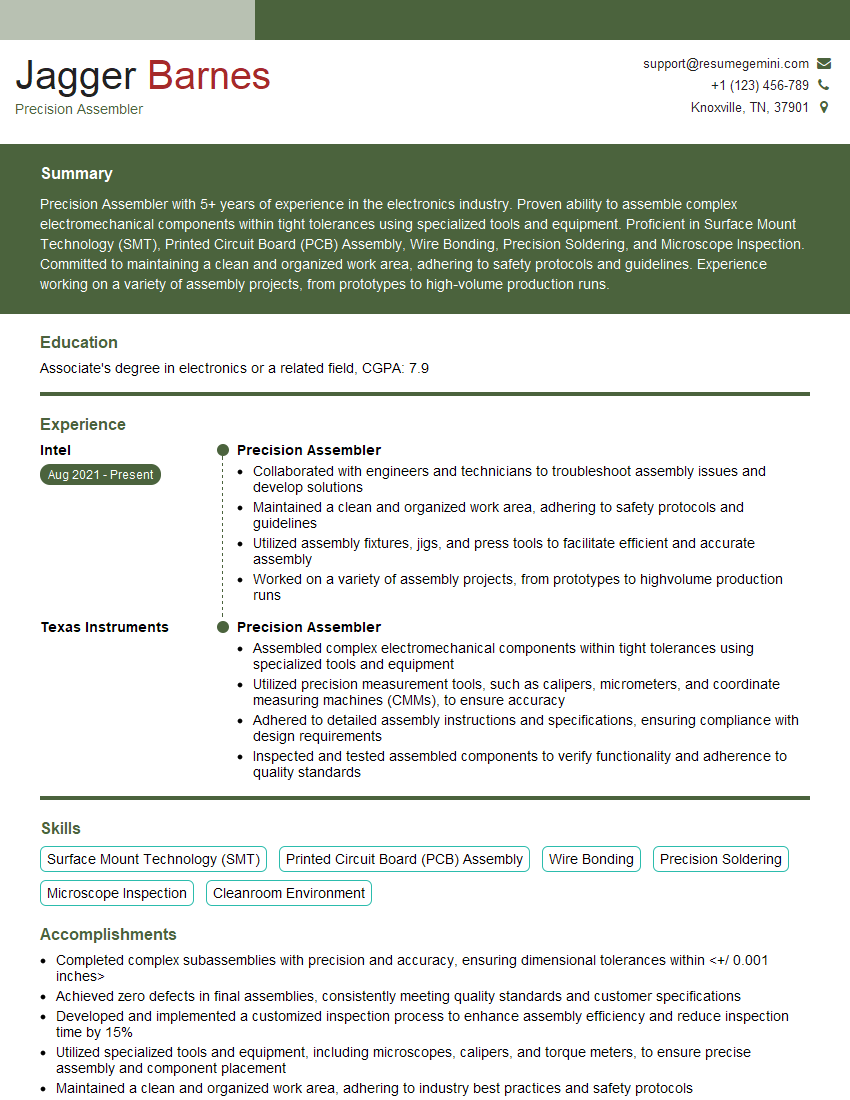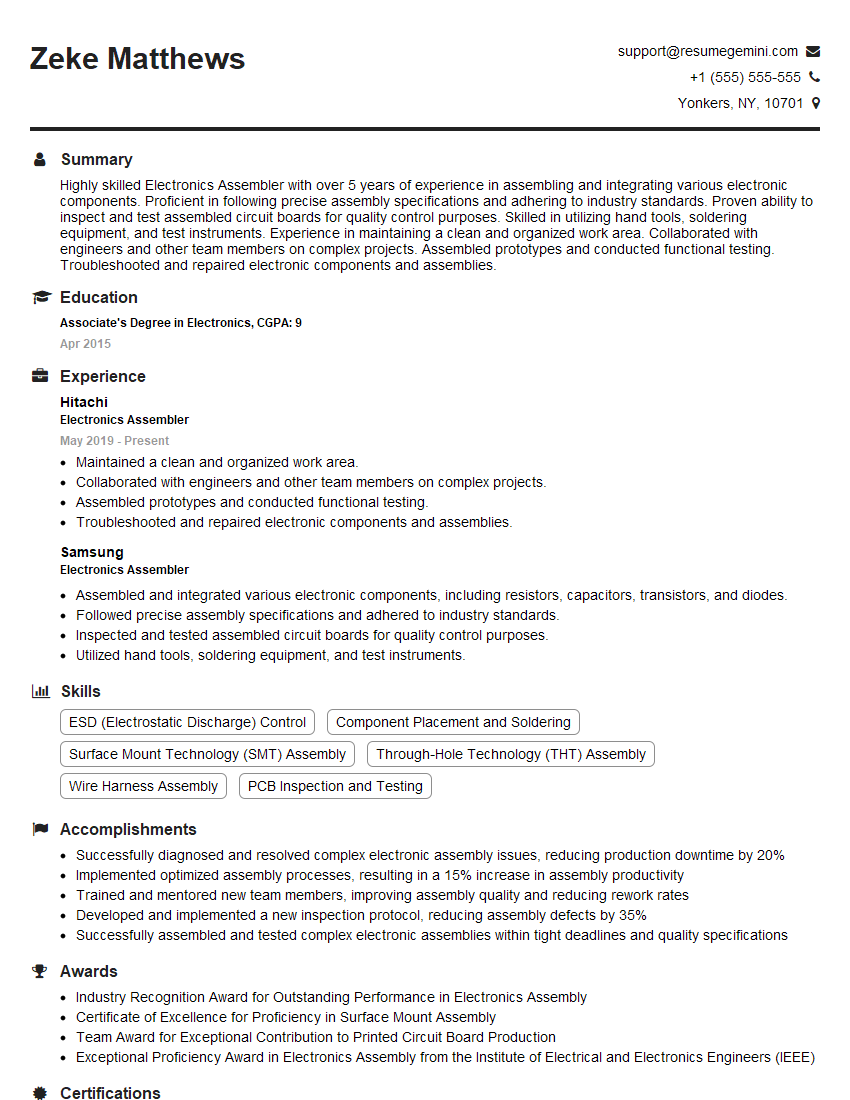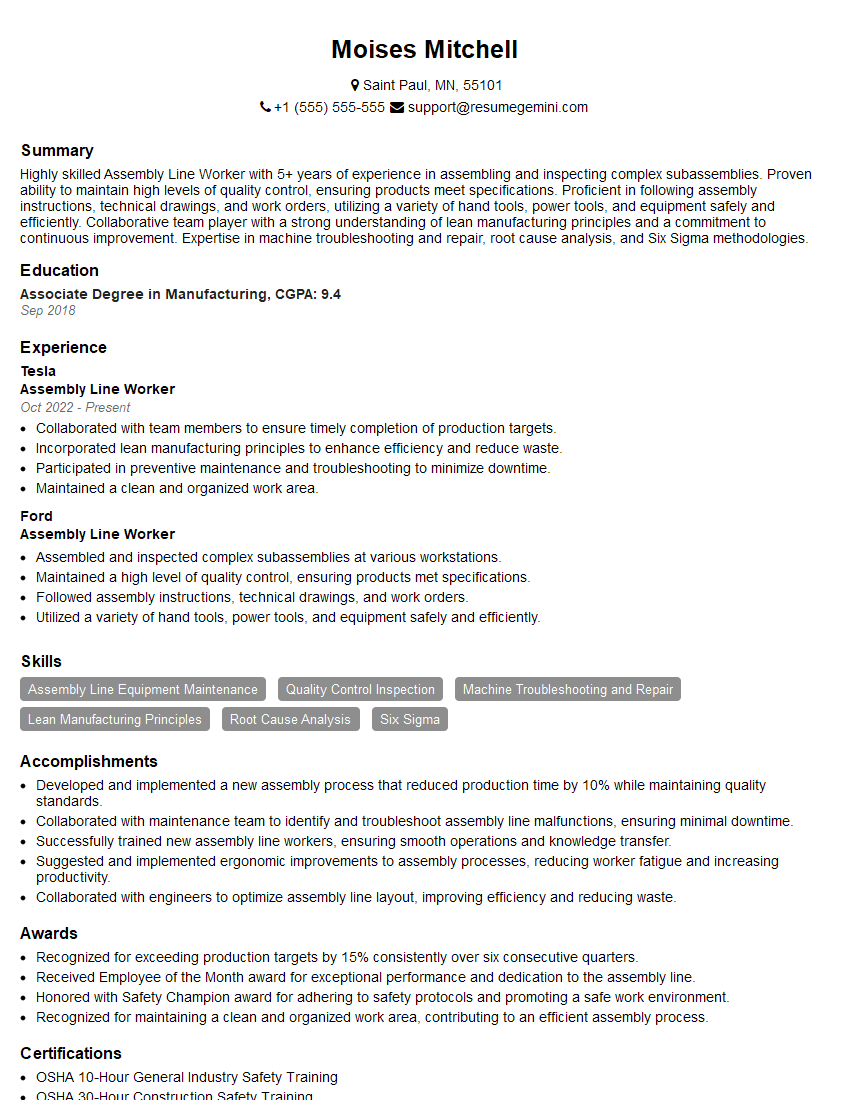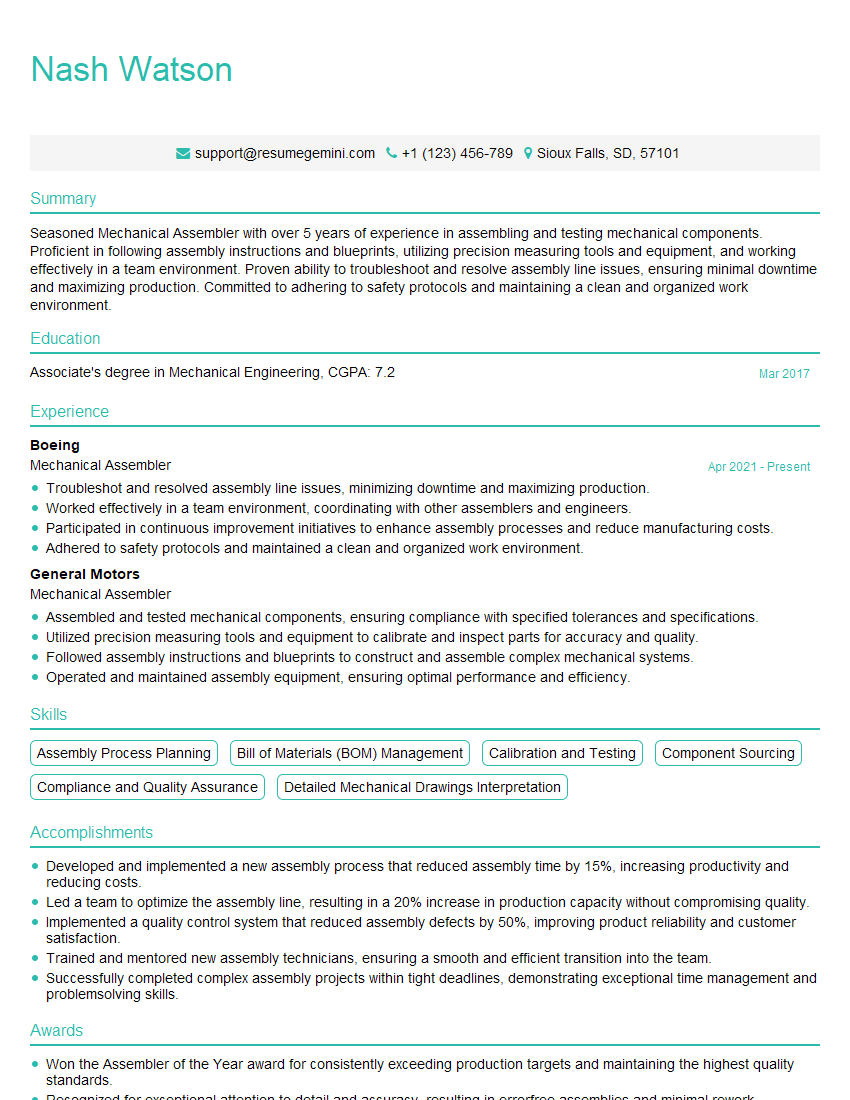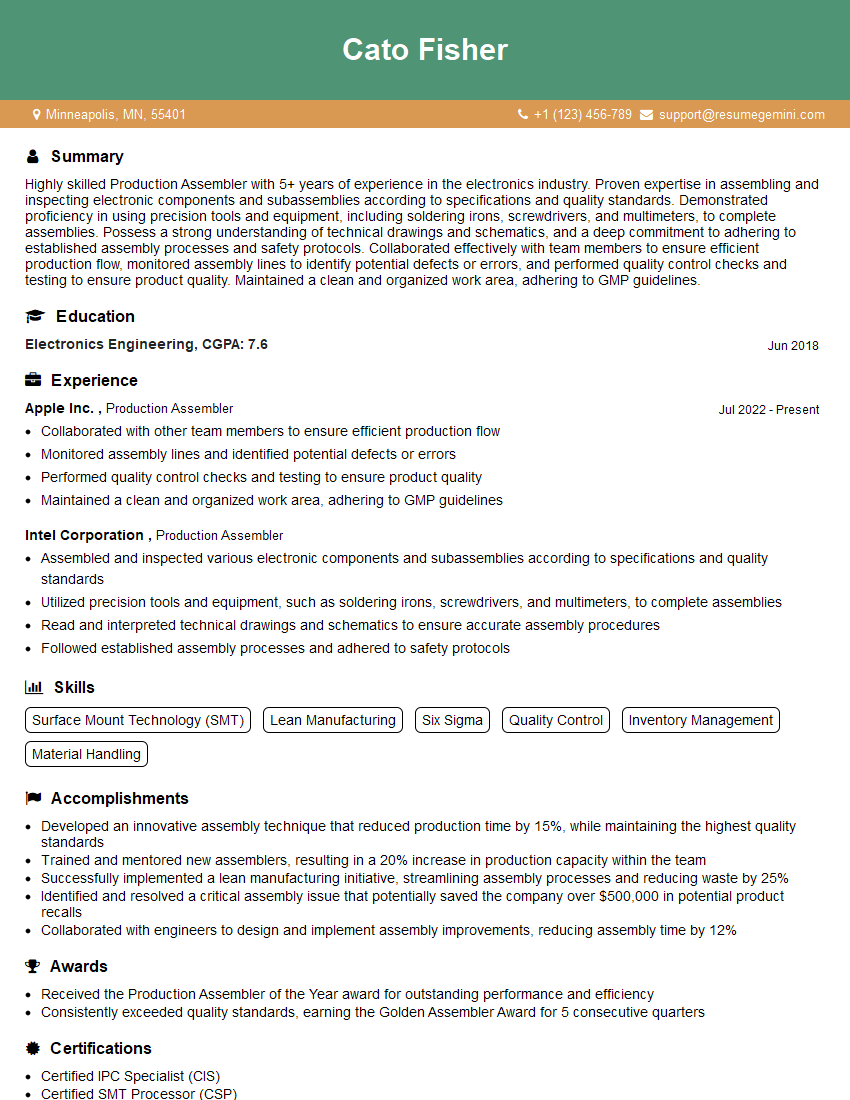Interviews are opportunities to demonstrate your expertise, and this guide is here to help you shine. Explore the essential Assembly of Fabricated Parts interview questions that employers frequently ask, paired with strategies for crafting responses that set you apart from the competition.
Questions Asked in Assembly of Fabricated Parts Interview
Q 1. Describe your experience with different assembly methods.
My experience encompasses a wide range of assembly methods, from simple hand assembly to more complex processes involving automated machinery. I’m proficient in various techniques, including:
- Manual Assembly: This involves assembling parts by hand, often using hand tools. I’ve extensively used this method for smaller, intricate assemblies where precision and dexterity are key. For example, assembling delicate electronic components requires careful attention to detail and the use of specialized tools.
- Mechanical Assembly: This utilizes machinery such as presses, robotic arms, or automated assembly lines for faster and more consistent production. I’ve worked with automated systems in automotive component manufacturing, where high-volume production necessitates automated processes.
- Jigs and Fixtures: I’m experienced in using jigs and fixtures to ensure consistent and accurate part placement and alignment during assembly. This is crucial for repeatable results and reduces errors, particularly in high-precision applications like aerospace manufacturing.
- Adhesive Bonding: I’m skilled in using various adhesives, ensuring proper surface preparation and curing times to achieve strong and reliable bonds. This is important when mechanical fasteners are not suitable or aesthetically undesirable.
My experience spans different industries, providing me with a versatile understanding of assembly processes tailored to specific product requirements.
Q 2. Explain your understanding of tolerances and their importance in assembly.
Tolerances are critical in assembly. They define the permissible variation in dimensions and other characteristics of parts. Think of it like fitting a key into a lock; if the tolerances are too loose, the key will wobble, and if too tight, it won’t even fit.
In assembly, tolerances impact fit, function, and overall product quality. Tight tolerances ensure precise fit and performance, but can increase manufacturing costs and complexity. Loose tolerances are less expensive but may compromise performance and reliability.
Understanding and managing tolerances requires careful consideration of several factors:
- Material Properties: Different materials expand and contract at different rates due to temperature variations. This must be factored into tolerance calculations.
- Manufacturing Processes: The precision of different manufacturing methods impacts the achievable tolerance. For instance, CNC machining typically offers tighter tolerances than casting.
- Assembly Methods: The assembly process itself can introduce variations. For example, a poorly aligned press fit can lead to misalignment, even if the individual parts are within tolerance.
Properly defined tolerances are documented in engineering drawings and specifications, and adhering to them is essential for successful product assembly.
Q 3. How do you ensure the quality of assembled parts?
Ensuring quality in assembled parts requires a multi-faceted approach beginning with careful planning and continuing throughout the entire process.
- Inspection of incoming parts: I rigorously check incoming components for any defects or deviations from specifications before assembly begins. This prevents defective parts from entering the assembly line.
- Process Control: I closely monitor the assembly process itself, checking for consistent quality and identifying any potential issues early. This includes regular checks of tooling, equipment, and worker performance.
- In-process Inspection: I perform periodic inspections during assembly to identify and correct any problems before they lead to significant rework or scrap. This could involve visual inspection, dimensional checks using measuring tools, or functional testing of sub-assemblies.
- Final Inspection: A thorough final inspection of the completed assembly is vital to ensure it meets all quality standards and specifications. This may include functional tests, performance evaluations, and visual quality checks.
- Documentation: Meticulous record-keeping, including inspection reports and any corrective actions taken, is crucial for traceability and continuous improvement.
By employing these techniques, we can effectively identify and mitigate quality issues, thereby increasing customer satisfaction and reducing costs.
Q 4. What are your troubleshooting skills when assembly issues arise?
Troubleshooting assembly issues requires a systematic approach. My strategy typically involves:
- Identify the Problem: Clearly define the issue – is it a dimensional problem, a fit issue, or a functional failure?
- Gather Information: Collect data – review assembly drawings, inspect parts, check tolerances, and examine the assembly process for any deviations from the standard procedure.
- Isolate the Cause: Use the gathered information to pinpoint the root cause. Is it a defective part, an incorrect procedure, or a problem with the tooling or equipment?
- Develop and Implement a Solution: Based on the identified root cause, develop and implement a solution. This may involve replacing a defective part, adjusting the assembly process, or modifying tooling.
- Verify the Solution: After implementing the solution, verify that it resolves the problem and does not introduce new issues. Thorough testing is crucial here.
- Document the Issue and Solution: Maintain a record of the problem, its root cause, and the solution implemented. This information can help prevent similar problems from occurring in the future.
For example, if parts aren’t fitting correctly, I would investigate tolerances, check for burrs or damage on parts, and examine the alignment of assembly jigs and fixtures.
Q 5. Describe your experience with various hand tools and power tools used in assembly.
My experience includes proficiency in a wide range of hand and power tools commonly used in assembly.
- Hand Tools: I’m highly skilled in using screwdrivers (various types and sizes), wrenches (open-end, box-end, socket), pliers (needle-nose, slip-joint), hammers, punches, chisels, and various measuring tools (calipers, micrometers, rulers).
- Power Tools: I am experienced in using power drills (various chuck sizes and speeds), impact wrenches, pneumatic rivet guns, and automated screw-driving systems. Safety is always my top priority when using power tools, ensuring I always use appropriate safety equipment.
My experience allows me to select the appropriate tool for the job, optimizing efficiency and minimizing risk of damage to parts or injury.
Q 6. How familiar are you with different types of fasteners (screws, bolts, rivets)?
I have extensive familiarity with different types of fasteners, understanding their strengths, weaknesses, and appropriate applications.
- Screws: I understand the different types (machine screws, self-tapping screws, wood screws) and their applications, considering factors such as material, thread pitch, and head type.
- Bolts: I’m experienced with various bolt types (carriage bolts, machine bolts, hex bolts), understanding the importance of appropriate torque and washer selection for optimal performance and preventing damage.
- Rivets: I know how to use solid, blind, and semi-tubular rivets, selecting the appropriate type based on the application and material properties.
Choosing the right fastener is critical for the structural integrity and reliability of the assembled product, and my expertise ensures optimal fastener selection for each situation.
Q 7. What safety procedures do you follow during the assembly process?
Safety is paramount during the assembly process. My consistent adherence to safety procedures includes:
- Personal Protective Equipment (PPE): I always wear appropriate PPE, including safety glasses, gloves, hearing protection (when necessary), and steel-toed shoes.
- Tool Safety: I ensure all tools are in good working order and used correctly. I regularly inspect tools for damage and replace or repair them as needed.
- Ergonomics: I maintain proper posture and use ergonomic practices to avoid strain and injury. For repetitive tasks, I’m aware of the importance of taking breaks to prevent fatigue.
- Hazardous Materials: I follow all safety protocols when handling hazardous materials such as adhesives, solvents, or lubricants, ensuring proper ventilation and disposal procedures are followed.
- Lockout/Tagout Procedures: I’m familiar with and adhere to lockout/tagout procedures when working with machinery to prevent accidental starts and injuries.
- Emergency Procedures: I’m trained on emergency procedures and know how to respond to any accidents or incidents.
A safe work environment is not only a legal requirement but also essential for maintaining productivity and preventing injuries. My dedication to safety ensures that the assembly process is both efficient and hazard-free.
Q 8. How do you interpret technical drawings and assembly instructions?
Interpreting technical drawings and assembly instructions requires a systematic approach. I start by understanding the overall design intent, looking at the title block for part numbers, revision levels, and any relevant notes. Then, I meticulously examine each view – orthographic projections (top, front, side) – to grasp the component’s geometry and dimensions. Detailed views, sections, and cross-sections reveal internal features. I pay close attention to tolerances (how precise the measurements must be), surface finishes, and material specifications. Assembly instructions are then reviewed to understand the sequence of operations, including fastening methods, torque specifications, and any special handling instructions. I often create a physical representation in my mind, visualizing the assembly process step-by-step before starting. For complex assemblies, I may even create a preliminary mock-up using simpler materials to confirm my understanding.
For example, imagine assembling a complex gear box. The drawings show the individual gears, shafts, and housings. I’d identify each part, verify its dimensions, and note its surface finish. The instructions would detail the order of assembly, such as inserting bearings into shafts before mounting them into the housing, and specifying the correct torque for each fastener to ensure correct function and prevent damage.
Q 9. Explain your experience with working from blueprints or schematics.
My experience with blueprints and schematics spans over ten years, working across a variety of industries, including automotive, medical device manufacturing, and aerospace. I’ve worked with both 2D and 3D models (SolidWorks, AutoCAD, Creo), extracting essential information regarding component design, material selection, and manufacturing processes. I’m proficient in interpreting various drafting standards (ANSI, ISO). I’ve routinely used blueprints to procure parts, plan assembly sequences, troubleshoot assembly issues, and train new team members. A recent project involved assembling a complex robotic arm. The schematics outlined the electrical wiring, hydraulic routing, and the mechanical assembly, requiring a thorough understanding of the whole system to ensure correct functioning.
Q 10. How do you handle discrepancies between assembly instructions and actual parts?
Discrepancies between assembly instructions and actual parts are addressed systematically and professionally. First, I verify the part numbers and revision levels against the drawings. A simple mislabeling or an outdated instruction sheet can often be the culprit. If the discrepancy persists, I document the issue meticulously, including photographs and detailed notes of the differences. I then escalate the issue to the engineering or quality control department for resolution. In some cases, minor adjustments might be possible (within tolerance limits) if the discrepancy is insignificant and doesn’t compromise the structural integrity or functionality of the assembly. Otherwise, a change order would need to be initiated to update the drawings or instructions. It’s crucial to ensure consistency and prevent errors from propagating throughout the production line.
For instance, if an instruction calls for a specific bolt size but the part supplied is a different size, I’d document this with photos, indicating the instruction error. This documentation would then be communicated to engineering to prevent further errors.
Q 11. What is your experience with using jigs and fixtures?
Jigs and fixtures are essential for ensuring consistent and accurate assembly. My experience includes extensive use of various jigs and fixtures, from simple clamps and guides to more complex custom-designed devices. I understand how to select the appropriate jig or fixture based on the assembly task, considering factors such as part geometry, required precision, and production volume. I’m also familiar with designing simple jigs using readily available materials like wood or metal, modifying existing fixtures to adapt to changing requirements, and maintaining the proper care and storage of tools and fixtures. This allows for greater efficiency and repeatability in the assembly process.
Q 12. Describe your experience with different assembly jigs and their applications.
I’ve worked with a range of assembly jigs and fixtures, including:
- Drill jigs: These guide the drill bit to ensure precise hole placement.
- Welding fixtures: These hold parts in the correct position for welding operations, ensuring consistent weld quality.
- Clamping fixtures: Used to hold components together during assembly processes such as gluing or bolting.
- Inspection fixtures: These are used to verify that the assembled components are within tolerance.
- Automated fixtures: Incorporated into robotic assembly systems, these fixtures precisely position parts for automated assembly.
The application depends on the specific task. For example, when assembling a circuit board, a drill jig ensures that holes are precisely drilled for component placement, while a clamping fixture securely holds the components in place while soldering. Understanding the specific needs and the application will always influence my selection of tooling.
Q 13. How do you manage your time and prioritize tasks in an assembly environment?
Time management and task prioritization are critical in an assembly environment. I use a combination of techniques, including:
- Task breakdown: Complex assemblies are broken down into smaller, manageable tasks. This allows for better tracking of progress and more realistic time estimates.
- Prioritization: Tasks are prioritized based on urgency and dependency. Critical path activities are tackled first to avoid delays.
- Visual aids: Kanban boards or similar visual management tools are used to track progress and identify bottlenecks.
- Communication: Maintaining open communication with team members ensures that any unexpected issues are addressed promptly.
- Continuous improvement: Regularly reviewing processes and identifying areas for improvement is essential for optimizing efficiency.
For example, in assembling a complex product with multiple sub-assemblies, I’d start by prioritizing the sub-assemblies that are critical for the final product to function and then work my way through to the less critical parts. I use visual aids to track which step I am in, and keep track of how long certain steps are taking to help me improve my efficiency.
Q 14. What is your experience with automated assembly equipment?
My experience with automated assembly equipment includes working with robotic arms, automated screw drivers, and automated parts feeders. I’m familiar with the programming and operation of these systems, as well as the troubleshooting and maintenance required to keep them running smoothly. I understand the benefits of automation, such as increased productivity and consistency, but also recognize the need for human oversight to ensure quality and address unexpected issues. A recent project involved integrating a robotic arm into an assembly line for installing small electronic components. My role included programming the robot’s movements, ensuring proper part feeding, and troubleshooting any malfunctions.
Q 15. How do you maintain a clean and organized workspace?
Maintaining a clean and organized workspace is paramount in assembly, impacting both efficiency and safety. Think of it like a well-organized kitchen – you can find ingredients (parts) easily and work smoothly. My approach involves several key strategies:
- 5S Methodology: I rigorously apply the 5S principles – Sort, Set in Order, Shine, Standardize, and Sustain. This ensures all tools, parts, and materials are in their designated places, readily accessible, and the workspace is always clean and free from clutter.
- Visual Management: I utilize visual cues like shadow boards for tools, labeled bins for parts, and color-coded systems for identifying different components. This makes it instantly clear where everything belongs, reducing search time and preventing errors.
- Regular Cleaning: I incorporate regular cleaning into my workflow, not just at the end of the day. This prevents debris buildup that can interfere with assembly or even damage components. A quick wipe-down of surfaces after each task is standard practice.
- Preventive Maintenance: I regularly inspect tools and equipment to ensure they’re in good working order and promptly report any issues. This prevents unexpected downtime and maintains the overall cleanliness and safety of the workspace.
In practice, this translates to a significantly smoother assembly process, fewer errors, and improved overall productivity. A clean workspace is a safe workspace.
Career Expert Tips:
- Ace those interviews! Prepare effectively by reviewing the Top 50 Most Common Interview Questions on ResumeGemini.
- Navigate your job search with confidence! Explore a wide range of Career Tips on ResumeGemini. Learn about common challenges and recommendations to overcome them.
- Craft the perfect resume! Master the Art of Resume Writing with ResumeGemini’s guide. Showcase your unique qualifications and achievements effectively.
- Don’t miss out on holiday savings! Build your dream resume with ResumeGemini’s ATS optimized templates.
Q 16. Describe a time you had to solve a complex assembly problem.
During the assembly of a complex robotic arm, we encountered a significant challenge with the alignment of the servo motors. The initial design specified a tight tolerance, but due to minor variations in the manufactured parts, achieving perfect alignment proved impossible using standard methods.
To solve this, I employed a multi-pronged approach:
- Root Cause Analysis: We meticulously analyzed the variations in the servo motor housings using a CMM (Coordinate Measuring Machine) to pinpoint the source of the misalignment.
- Iterative Adjustment: Instead of relying solely on the initial design, we implemented an iterative adjustment process. This involved making small, incremental adjustments to the mounting brackets while continuously verifying alignment with the CMM.
- Shimming: We introduced precision shims of varying thicknesses to compensate for the minor dimensional inconsistencies identified in the root cause analysis. This ensured a precise fit without needing to rework the housings.
- Documentation: We meticulously documented each step of the adjustment process, including the measurements and the shim configurations used. This ensures reproducibility and simplified troubleshooting in future assemblies.
This problem-solving approach not only resolved the immediate issue but also provided valuable insights into the manufacturing process and improved the design for future iterations. The result was a perfectly functioning robotic arm that met the required specifications.
Q 17. What are your experience with different types of adhesives and their applications?
My experience encompasses a wide range of adhesives, each with specific properties and applications. Choosing the right adhesive is crucial for the durability and integrity of the final assembly.
- Cyanoacrylate (Super Glue): Excellent for bonding small parts quickly, but has limited strength and can be brittle. Useful for small, non-structural components.
- Epoxy Resins: Offer high strength and excellent adhesion to a variety of materials. Ideal for structural bonding, particularly in applications requiring high shear strength. Two-part epoxy offers longer working times, allowing for more precise application.
- Anaerobic Adhesives: Cure in the absence of air, making them ideal for sealing threaded connections or preventing leaks. They offer excellent resistance to vibration and chemicals.
- UV-Curable Adhesives: Cure rapidly upon exposure to ultraviolet light, offering quick processing times and are perfect for automated assembly lines.
- Hot Melt Adhesives: Applied in molten form and solidify upon cooling, offering a quick and easy bonding method for low-strength applications.
Selecting the appropriate adhesive depends on factors such as the materials being bonded, the required strength, the working environment (temperature, chemicals), and the desired cure time. Each application requires careful consideration of these factors to ensure optimal performance.
Q 18. Describe your knowledge of different welding techniques used in assembly.
My knowledge of welding techniques in assembly is extensive, covering various methods depending on the materials and application requirements:
- Gas Metal Arc Welding (GMAW): A versatile process suitable for many metals, offering good penetration and speed. Ideal for automated applications and production runs.
- Gas Tungsten Arc Welding (GTAW): Provides excellent control and precision, producing high-quality welds with minimal distortion. Often used for thin materials or applications requiring high aesthetic quality.
- Shielded Metal Arc Welding (SMAW): Relatively simple and portable, making it suitable for various field applications. However, it can produce less consistent welds compared to other methods.
- Resistance Welding (Spot, Seam, Projection): Widely used for joining sheet metal in high-volume production. Efficient and requires minimal material preparation.
The choice of welding technique is determined by factors such as the materials being joined (e.g., steel, aluminum, stainless steel), the desired weld strength and quality, the joint design, and the production environment. Safety is always paramount, and appropriate safety precautions like proper ventilation and personal protective equipment (PPE) must be followed.
Q 19. How familiar are you with Lean Manufacturing principles and their application in assembly?
Lean Manufacturing principles are crucial for optimizing assembly processes. I’m well-versed in their application, focusing on eliminating waste and maximizing efficiency.
- Value Stream Mapping: I’ve used VSM to analyze the assembly process, identifying bottlenecks and areas for improvement. This visual tool helps pinpoint non-value-added steps that can be eliminated.
- Kaizen Events: I’ve participated in Kaizen events, focusing on continuous improvement initiatives to optimize assembly workflows and reduce cycle times.
- 5S Methodology (as applied to assembly): This is already part of my workspace organization strategies, eliminating waste and improving efficiency.
- Kanban: Implementing Kanban systems to manage material flow ensures that parts arrive at the assembly line just-in-time, reducing inventory and storage space.
- Poka-Yoke (Error-Proofing): Implementing Poka-Yoke methods like jigs, fixtures, and visual aids helps minimize errors during assembly, leading to higher quality and reduced rework.
By effectively applying Lean principles, we can streamline the assembly process, decrease production costs, and improve product quality. It’s all about delivering more value with less waste.
Q 20. How do you contribute to a team environment in assembly tasks?
Teamwork is essential in assembly, where complex projects require diverse skills and expertise. My contributions to a team environment include:
- Communication: I actively participate in team discussions, sharing my knowledge and insights openly. Clear communication is crucial to avoid misunderstandings and errors.
- Collaboration: I willingly collaborate with team members, sharing tasks and responsibilities to achieve common goals efficiently.
- Problem-Solving: I proactively identify and address challenges, contributing to solutions that improve overall team performance. I’m not afraid to ask for help if needed, fostering a culture of shared learning.
- Mentorship: I am happy to mentor and train less experienced team members, sharing my expertise and helping them develop their skills. This strengthens the team as a whole.
- Respectful Work Environment: I ensure a respectful and positive work environment where everyone feels comfortable contributing and sharing ideas. I believe that valuing diverse viewpoints leads to the best solutions.
A cohesive team creates a synergistic effect, resulting in higher-quality work and increased productivity.
Q 21. Explain your understanding of different assembly processes (e.g., hand assembly, automated assembly).
Assembly processes vary widely depending on factors like product complexity, production volume, and budget constraints. I have experience with various methods:
- Hand Assembly: This method is suitable for low-volume production or highly customized products. It requires skilled labor and precise attention to detail. Examples include assembling intricate mechanical clocks or specialized electronics.
- Automated Assembly: High-volume production often utilizes automated assembly lines. This includes robotic systems, automated guided vehicles (AGVs), and specialized assembly machinery. Automated processes enhance speed, consistency, and efficiency.
- Semi-Automated Assembly: This combines elements of both hand and automated assembly, often utilizing robotics for repetitive tasks while retaining human intervention for more complex or customized steps. This hybrid approach balances the benefits of automation with the flexibility of human labor.
- Mixed-Model Assembly: This is particularly relevant in high-mix, low-volume settings. The line is designed to efficiently handle a variety of products while maintaining a smooth workflow.
Understanding the strengths and limitations of each assembly process is crucial for selecting the most appropriate and cost-effective approach for a specific project. A thorough analysis of product design, volume, and budget constraints guides the choice of the optimal assembly method.
Q 22. How do you ensure the accuracy and precision required during assembly?
Ensuring accuracy and precision in assembly is paramount. It’s like building a house – if the foundation isn’t perfectly square, the whole structure will be off. We achieve this through a multi-pronged approach:
- Precise Measurement: Using calibrated tools like micrometers and calipers, we meticulously measure each component before and during assembly to ensure it conforms to specifications. For example, a slight deviation in a bearing’s diameter can lead to premature wear and failure.
- Jig and Fixture Usage: We employ jigs and fixtures – specialized tools that guide and constrain parts during assembly, preventing misalignment and ensuring repeatability. Imagine a jig as a template that holds a piece in place, allowing for consistent placement of other parts.
- Process Documentation: Detailed assembly instructions, including tolerance ranges and sequence of operations, are followed strictly. This ensures consistency across all units assembled.
- Regular Calibration: Our tools and equipment undergo regular calibration to maintain their accuracy. This prevents the accumulation of small errors that can snowball into significant problems.
- Statistical Process Control (SPC): We use SPC methods to monitor the assembly process and identify potential issues before they lead to widespread defects. This allows for proactive adjustments and adjustments and prevents production of defective products.
By combining these methods, we can confidently assemble parts with the required accuracy and precision, ensuring product quality and reliability.
Q 23. Describe your experience working with different materials (e.g., metals, plastics, composites).
My experience spans a wide range of materials, each presenting unique challenges and requiring specialized techniques:
- Metals: I’ve worked extensively with various metals like aluminum, steel, and stainless steel. These materials require precise machining and careful handling to avoid damage or deformation during assembly. For example, when assembling aluminum components, we needed to ensure no scratches occured to maintain surface quality.
- Plastics: I have experience assembling parts made from different plastics, including ABS, polycarbonate, and nylon. These materials require careful consideration of material properties, including their susceptibility to heat and stress, during assembly to prevent warping or breakage. Working with plastics requires gentler techniques compared to metals.
- Composites: My experience also includes working with carbon fiber composites. These materials are incredibly strong but also brittle, requiring meticulous care during handling and assembly. Specialized tooling and adhesives are often essential in handling composites.
Understanding the properties of each material is critical for selecting the appropriate assembly techniques, tools, and adhesives to ensure a robust and reliable final product.
Q 24. What is your experience with quality control checks during and after assembly?
Quality control is integrated throughout the entire assembly process, from the initial inspection of raw materials to the final product testing:
- In-Process Checks: At various stages of assembly, we perform checks using measuring instruments (calipers, micrometers) to verify that each part is correctly positioned and within tolerance. This ensures we identify and correct any errors early, preventing further work on faulty assemblies.
- Visual Inspection: Thorough visual inspections are conducted to identify any defects such as scratches, dents, or misalignments. This is particularly important for aesthetic components.
- Functional Testing: Once the assembly is complete, functional tests are performed to verify that it performs as intended. This can include mechanical, electrical, or other specialized tests, depending on the product.
- Documentation: All quality control checks are meticulously documented, providing a complete audit trail and facilitating continuous improvement of the assembly process.
This multi-layered approach to quality control helps ensure the consistent production of high-quality, reliable products.
Q 25. How do you handle working under pressure and meeting tight deadlines?
Working under pressure and meeting tight deadlines is a regular aspect of my work. My approach involves:
- Prioritization: I prioritize tasks based on their urgency and impact, ensuring that critical aspects of the assembly are completed first. This prevents delays caused by focusing on less important aspects.
- Effective Communication: Open communication with team members and management helps to proactively identify and address potential roadblocks. Sharing updates and potential delays early avoids unforeseen crises.
- Efficient Workflow: I streamline my workflow by optimizing processes and utilizing efficient techniques, reducing wasted time and maximizing productivity. This includes using lean manufacturing principles to minimize waste and maximize efficiency.
- Problem-Solving: When challenges arise, I approach them methodically, identifying the root cause and implementing the most effective solution. Panicking never helps, taking a structured approach to problem-solving is key.
By adopting these strategies, I consistently deliver high-quality work within demanding timeframes.
Q 26. Describe your proficiency with using measuring instruments (calipers, micrometers).
I am proficient in using various measuring instruments, including calipers and micrometers. My experience goes beyond simply reading measurements; I understand the principles behind their operation and the potential sources of error.
- Calipers: I can accurately use both inside, outside, and depth calipers to measure dimensions with a high degree of precision. I understand the importance of zeroing the caliper and applying consistent pressure to obtain accurate readings.
- Micrometers: I am skilled in using micrometers to measure dimensions with even greater precision than calipers, understanding the importance of proper thimble rotation and minimizing parallax error. Micrometers are used when extreme accuracy is required for critical dimensions.
- Error Reduction: I am aware of potential errors like parallax and improper handling and employ techniques to minimize these errors, such as using a consistent measuring technique and frequently checking the calibration of my instruments.
Accuracy in measurement is crucial to successful assembly, and my proficiency with these tools ensures that I consistently achieve the required precision.
Q 27. What is your experience with using computer aided design (CAD) software in assembly?
While not directly involved in CAD design, I have extensive experience utilizing CAD software in the assembly process:
- Understanding Designs: I use CAD models to understand the assembly sequence, identify potential interference issues, and confirm part fit before beginning the assembly. This prevents issues and costly rework.
- Digital Mockups: I use digital mockups to plan the assembly process, ensuring that the tools and jigs are compatible and the steps are efficient and safe.
- Tolerance Analysis: I can analyze tolerances from CAD models to ensure that parts will assemble successfully considering variations in manufacturing. This is critical for successful assembly.
- Reference Data: CAD models provide detailed information on part dimensions and tolerances, which is crucial for accurate measurement and assembly.
My familiarity with CAD software enhances my efficiency and reduces the likelihood of errors during assembly.
Q 28. How do you stay updated with the latest advancements in assembly techniques and technologies?
Staying updated with advancements in assembly techniques and technologies is crucial in this dynamic field. I employ several strategies:
- Professional Development: I regularly attend industry conferences, workshops, and training courses to learn about new techniques and technologies. This includes courses on new automation, robotics and new materials.
- Industry Publications: I subscribe to industry publications and journals to keep abreast of the latest research, trends, and best practices in assembly. This exposes me to new trends and techniques in assembly.
- Online Resources: I utilize online resources such as technical websites, forums, and webinars to access valuable information and connect with other professionals in the field. This enables peer-to-peer learning.
- Collaboration: I actively collaborate with colleagues and experts to exchange knowledge and insights about new technologies and assembly techniques. Sharing knowledge across the industry is vital for improvement.
Continuous learning ensures that I remain at the forefront of the industry, applying the most efficient and effective methods in my work.
Key Topics to Learn for Assembly of Fabricated Parts Interview
- Understanding Drawings and Specifications: Interpreting blueprints, technical drawings, and specifications to understand the assembly process and component requirements. This includes identifying tolerances, materials, and finishes.
- Assembly Methods and Techniques: Familiarizing yourself with various assembly methods like bolting, riveting, welding (if applicable), adhesive bonding, and press-fitting. Understand the strengths and limitations of each method and their application in different scenarios.
- Quality Control and Inspection: Knowing how to perform quality checks throughout the assembly process, identifying potential defects, and understanding relevant quality control standards and documentation procedures. This includes understanding tolerance limits and the use of measuring tools.
- Tools and Equipment: Demonstrating familiarity with common hand tools, power tools, and specialized equipment used in assembling fabricated parts. This might include pneumatic tools, torque wrenches, and specialized fixtures.
- Troubleshooting and Problem-solving: Being able to identify and resolve common assembly issues, such as misalignment, faulty components, or improper fastening. This involves a systematic approach to problem diagnosis and solution implementation.
- Safety Procedures and Regulations: Understanding and adhering to relevant safety regulations and procedures in the workplace, including the proper use of personal protective equipment (PPE) and safe handling of tools and materials.
- Lean Manufacturing Principles (if applicable): Demonstrating knowledge of lean manufacturing principles, such as reducing waste, optimizing workflow, and improving efficiency in the assembly process.
Next Steps
Mastering the assembly of fabricated parts is crucial for career advancement in manufacturing and related fields. A strong understanding of these processes demonstrates valuable technical skills and problem-solving abilities, opening doors to higher-paying roles and increased responsibility. To maximize your job prospects, creating an ATS-friendly resume is essential. ResumeGemini is a trusted resource that can help you build a professional and effective resume that highlights your skills and experience. Examples of resumes tailored to Assembly of Fabricated Parts are available to guide you through the process, showcasing how to effectively present your qualifications to potential employers.
Explore more articles
Users Rating of Our Blogs
Share Your Experience
We value your feedback! Please rate our content and share your thoughts (optional).
What Readers Say About Our Blog
Hello,
We found issues with your domain’s email setup that may be sending your messages to spam or blocking them completely. InboxShield Mini shows you how to fix it in minutes — no tech skills required.
Scan your domain now for details: https://inboxshield-mini.com/
— Adam @ InboxShield Mini
Reply STOP to unsubscribe
Hi, are you owner of interviewgemini.com? What if I told you I could help you find extra time in your schedule, reconnect with leads you didn’t even realize you missed, and bring in more “I want to work with you” conversations, without increasing your ad spend or hiring a full-time employee?
All with a flexible, budget-friendly service that could easily pay for itself. Sounds good?
Would it be nice to jump on a quick 10-minute call so I can show you exactly how we make this work?
Best,
Hapei
Marketing Director
Hey, I know you’re the owner of interviewgemini.com. I’ll be quick.
Fundraising for your business is tough and time-consuming. We make it easier by guaranteeing two private investor meetings each month, for six months. No demos, no pitch events – just direct introductions to active investors matched to your startup.
If youR17;re raising, this could help you build real momentum. Want me to send more info?
Hi, I represent an SEO company that specialises in getting you AI citations and higher rankings on Google. I’d like to offer you a 100% free SEO audit for your website. Would you be interested?
Hi, I represent an SEO company that specialises in getting you AI citations and higher rankings on Google. I’d like to offer you a 100% free SEO audit for your website. Would you be interested?
good

